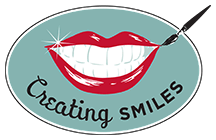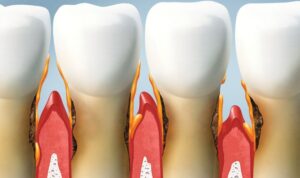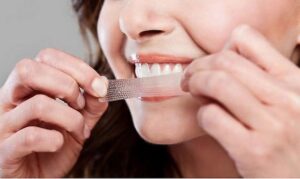Gum recession – a common dental issue that affects many people. But what exactly is it, and what can you do about it? Imagine your gums as the pink shoreline of your smile. When this shoreline starts to shrink back it starts exposing more of the tooth root underneath, that’s gum recession. It can happen for a few reasons, like brushing too hard, hormonal changes, or even genetics. While receding gums themselves aren’t necessarily painful, they can be unsightly and make your teeth more sensitive. More importantly, they can be a sign of underlying gum disease, which can eventually lead to tooth loss.
So, if you’ve noticed your gums creeping downwards, it’s best to talk to your dentist. They can assess the situation and recommend the best course of action, which might include some form of periodontal treatment.
Here’s the good news: receding gums can’t be reversed, but they can definitely be stopped in their tracks. Here are some common periodontal treatments used to address receding gums:
- Scaling and Root Planning: This deep cleaning tackles the root cause of gum recession – plaque and tartar buildup. Think of it as a power wash for your teeth, removing the gunk that irritates your gums and creates pockets where bacteria love to hide. This non-surgical treatment is usually the first line of defense, especially if gum disease is caught early.
- Antibiotics: Sometimes, after a deep cleaning, your dentist might prescribe antibiotics to fight off any remaining infection. These are usually short-term courses to ensure a healthy environment for your gums to heal.
- Antimicrobial Mouthwash: Brushing and flossing are fantastic, but they can’t always reach every nook and cranny. An antimicrobial mouthwash can be a great addition to your routine, helping to kill bacteria and reduce inflammation in your gums.
Now, let’s talk about some treatments that can actually rebuild lost gum tissue:
- Gum Grafting: This is where a superhero dentist (okay, a periodontist, which is a gum specialist) takes healthy gum tissue from another area of your mouth, like the roof, and transplants it to the receded area. This creates a new, secure gum line around your tooth root. It sounds fancy, but it’s a relatively common procedure with excellent long-term results.
- Soft Tissue Grafts: There are different types of gum graft procedures, but a common one uses tissue from under the flap of skin on the roof of your mouth. This tissue is then stitched to the gum tissue surrounding the exposed root, covering it up and creating a new, healthy barrier.
- Regeneration Techniques: If the bone supporting your teeth has also been affected by gum recession, your dentist might recommend regenerative techniques. These involve using materials like membranes or gels to stimulate your body to regrow bone and gum tissue.
Read Also: Periodontal Treatment: Addressing Gum Health
Remember, prevention is always better than cure. Here are some tips to keep your gums healthy and prevent receding gums in the first place:
- Brushing and Flossing: Twice a day, folks. Use a soft-bristled brush and a gentle technique to clean both your teeth and your gum line. Flossing daily removes plaque and food particles from between your teeth, where it can wreak havoc on your gums.
- Mind Your Brushing Technique: Brushing too hard can actually damage your gums. Be gentle and use a circular motion, focusing on cleaning the plaque away from the gum line.
- Consider an Electric Toothbrush: These can be a great way to ensure you’re brushing effectively and gently.
- Regular Dental Checkups: Don’t skip those appointments. Your dentist can monitor your gum health and catch any problems early on.
- Quit Smoking: Smoking is a major risk factor for gum disease and can worsen receding gums.
Taking care of your gums is just as important as taking care of your teeth. After all, healthy gums are the foundation for a healthy, beautiful smile. If you’re concerned about receding gums, don’t hesitate to talk to your dentist for periodontal treatment. With proper treatment and good oral hygiene habits, you can keep your smile bright and healthy for years to come.






